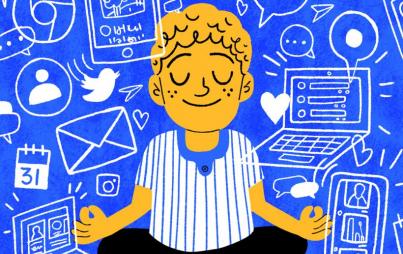
Photo by Brooke Lark on Unsplash
This article by Dr. Georgia Witkin first appeared on Fairygodboss and has been republished with permission.
As I look around my office, I know that one in ten of my colleagues have social anxiety. But I still feel like it’s my secret problem. My colleagues would describe me as outgoing and relaxed. But in the past, when I had to speak in front of a large group, mingle at company parties or meet with executives, my heart would start to race, I was short of breath and my leg would start to shake. When I was younger, I thought I would grow out of it. When I didn’t, I decided that this was me and that there was nothing I could do about it except to avoid as many terrifying situations as I could. Finally, there came a point where I couldn’t avoid the triggers for my social anxiety and advance in my career. I knew I had to start doing something about it.
If you have social anxiety, here are the six things that helped me through it.
1. Exposure in vivo.
Every time we avoid a scary social situation, our anxiety drops and we’ve rewarded ourselves for running away, ensuring that we’ll run away again. Exposure in vivo asks you to make yourself go through the anxiety-provoking situation instead of running away. To make it easier, I started with short exposures. For example, since I hated going to events alone, I would go to an event but would allow myself to leave after 15 minutes. I realized that I could tolerate the discomfort and would stay a bit longer at each event. I still hate walking into events alone — but now, I know I can do it. And by using some of the strategies below, I've ended up enjoying myself.
2. Cognitive restructuring.
This technique teaches us to turn our focus inside out. Since most social anxiety is caused by focusing inwards, one way to deal with social anxiety is to switch our attention outwards. In other words, instead of worrying about how you appear to everyone else (outside in), focus instead on how everyone else appears to you (inside out!). Now, when I give a presentation, I focus on what I want to say (inside out), not how I sound (outside in). When I go to an event, I focus on who I want to talk to (inside out), not who is coming over to me (outside in). After all, we can never really know what others are thinking, anyway.
You Might Also Like: Confession: I Hate Breathing Exercises
3. Cognitive Behavioral Therapy.
There are many CBT techniques for social anxiety, but this is the one that I use the most: I become an observer when I am socially anxious. For example, in the office, I pretend I’m writing a story about coworkers to give me some emotional distance. I ask them questions to stay in control of the conversation and then listen fully to their answers instead of worrying about what they are thinking of me.
4. Reality testing.
When embarrassing situations really do happen — and they do — I reassure myself that my anxiety will pass, and that I can handle it until it does. It has taken me a while to accept that most coworkers don't really notice or don't really care what I do and say as much as I think. It’s natural that they care more about themselves and about what they say and do. Here’s the best part: I’ve also learned that most of my officemates are more forgiving than I thought and want me to be forgiving, too. But I only learned all this by reality testing and pushing myself to do the things that make me anxious instead of avoiding them.
5. Applied relaxation.
There are many relaxation techniques and they all help social anxiety in two ways. First, they remind you how it feels to be relaxed and allows you to recognize when you start to tense up. Second, they teach you how to de-stress your mind and body. Here are two applied relaxation techniques:
Diaphragmatic rhythm: fill your belly, not your chest, with a gentle breath, then exhale easily and pause. Repeat, counting back from 10 to one, breathing in on each count.This technique can turn off my entire anxiety reaction in 30 seconds.
Progressive relaxation: take five minutes in bed in the morning before you get up. Close your eyes and start to relax your toes, then your feet, calves, legs, torso, back, hands, arms, shoulders, neck, and head. Then, imagine yourself floating until your eyes open by themselves. You can remind your body to relax this way every time you are in an elevator, stuck in traffic, about to make a presentation or small talk.
6. Mindfulness training.
This approach to social anxiety is as ancient as the Buddhist tradition and has been around for so long because it works. Since social anxiety increases when we dwell on our past mistakes or worry about our future ones, mindfulness brings us back to the here and now. Look around and focus on something you like on your desk or a picture on the office wall or a branch right outside the office window. It will get you accustomed to focusing on something external instead of your internal turmoil. For me, it’s like a psychological time-out from anxiety. I keep photos on my desk that make me smile and use them to refocus on the present moment.
No matter which techniques you choose, make sure to reward yourself when you take even the smallest step. Give yourself positive affirmations to recite whenever dire self-predictions pop into your thoughts and find a social anxiety ‘buddy’ or support group for mutual encouragement.
If you think you need professional help, find a therapist who specializes in social anxiety. They will know that it’s not a lack of social skills causing your problem. They will also know that there’s a lot of evidence that some of us are programmed to be hyper-alert to other’s reactions in social situations and need help in recognizing our overreactions and managing them.
More From Fairygodboss:
-
9 Signs You Have Unhealthy Personal Boundaries
-
21 Fun Facts About Yourself Worth Sharing At A Networking Event
-
How To Win Over A Difficult Coworker, Based On Their Zodiac Sign








